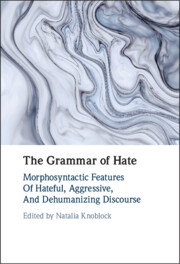Book contents
- The Grammar of Hate
- The Grammar of Hate
- Copyright page
- Contents
- Figures
- Tables
- Contributors
- Acknowledgments
- Introduction
- 1 Animacy and Countability of Slurs
- 2 Language Aggression in English Slang: The Case of the -o Suffix
- 3 Adj+ie/y Nominalizations in Contemporary English
- 4 Grammatical Gender and Offensiveness in Modern Greek Slang Vocabulary
- 5 Unseen Gender
- 6 The Neutering Neuter
- 7 Neutering Unpopular Politicians
- 8 The Power of a Pronoun
- 9 Is Play on Words Fair Play or Dirty Play?
- 10 Expressive German Adjective and Noun Compounds in Aggressive Discourse
- 11 ‘Kill the Invaders’
- 12 ‘I am no racist but …’
- 13 Homophobic Space–Times
- Index
- References
3 - Adj+ie/y Nominalizations in Contemporary English
From Diminution to Pejoration
Published online by Cambridge University Press: 30 June 2022
- The Grammar of Hate
- The Grammar of Hate
- Copyright page
- Contents
- Figures
- Tables
- Contributors
- Acknowledgments
- Introduction
- 1 Animacy and Countability of Slurs
- 2 Language Aggression in English Slang: The Case of the -o Suffix
- 3 Adj+ie/y Nominalizations in Contemporary English
- 4 Grammatical Gender and Offensiveness in Modern Greek Slang Vocabulary
- 5 Unseen Gender
- 6 The Neutering Neuter
- 7 Neutering Unpopular Politicians
- 8 The Power of a Pronoun
- 9 Is Play on Words Fair Play or Dirty Play?
- 10 Expressive German Adjective and Noun Compounds in Aggressive Discourse
- 11 ‘Kill the Invaders’
- 12 ‘I am no racist but …’
- 13 Homophobic Space–Times
- Index
- References
Summary
This study focuses on the nominalizing and evaluative function of the -ie/y suffix with the purpose of investigating how the changes in the semantics (diminutive → pejorative) of the output units are connected to the conceptual processes that employ evaluative morphological forms. This study reports on the qualitative analysis of 63 examples of Adj+ie/y nominalizations (e.g. softie, brownie) collected from a range of descriptive dictionaries of English. The analysis of the data employs a usage-based approach to Morphopragmatics and the Conceptual Integration Theory in order to explore cognitive operations that underlie the formation of pejoratives. The findings show that with the activation of the meanings [+human] and [+adult], the concept diminution is reconfigured as ‘small/insignificant in value’, whose utmost degree is understood as pejoration. A multilevel analysis of such nominalizations indicates that these suffixed forms are affected by the aspect of bidirectionality: whilst an Adj+ie/y nominalization, such as blackie, is formally represented through the morphological concept of diminution, size → insignificant also activates through a conceptual integration process.
- Type
- Chapter
- Information
- The Grammar of HateMorphosyntactic Features of Hateful, Aggressive, and Dehumanizing Discourse, pp. 59 - 81Publisher: Cambridge University PressPrint publication year: 2022
References
- 1
- Cited by



